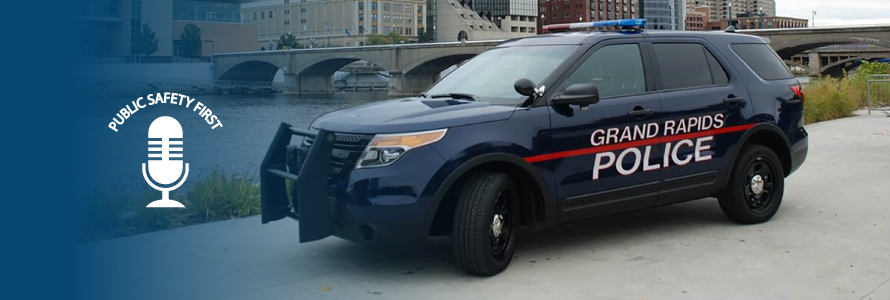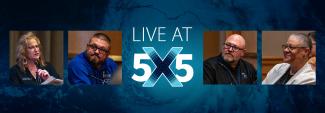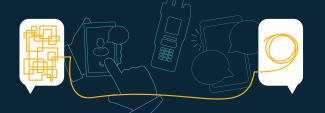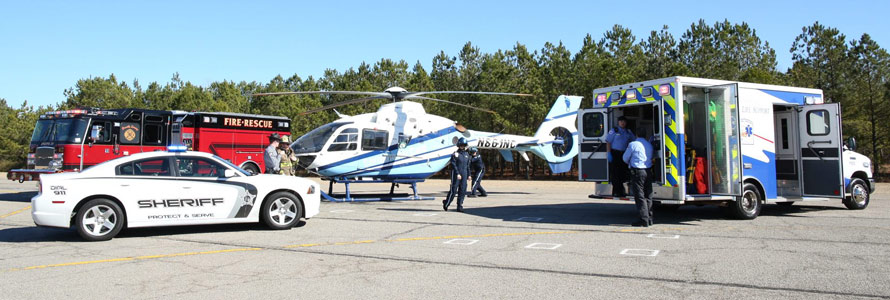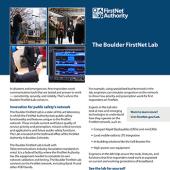Summary
The Grand Rapids Police Department in Michigan is a full-service law enforcement agency serving a largely urban community. Officers with the department began experiencing in-car computers slowing down and losing the ability to access systems and databases due to reduced bandwidth. Since switching to FirstNet, officers can access the software they need throughout the city, giving them greater mobility while providing cost savings to the department.
Guest
Kyle Richardson
FirstNet Authority Senior Public Safety Advisor
Captain Dave Schnurstein
Grand Rapids Police Department, Michigan
Transcript
Preview
Narrator: You're listening to Public Safety First, a podcast to help you learn about the First Responder Network Authority and how you can be part of the future of public safety technology.
And now, your host.
Kyle Richardson: Hi, and welcome to the Public Safety First podcast. I’m Kyle Richardson, a Senior Public Safety Advisor with the FirstNet Authority. Today, I’m joined by Captain David Schnurstein with the Grand Rapids Police Department in Michigan. Thanks so much for joining us today, Captain. Could you start by telling us about your background and what you do for Grand Rapids PD?
Narrator: You're listening to Public Safety First, a podcast to help you learn about the First Responder Network Authority and how you can be part of the future of public safety technology.
And now, your host.
Kyle Richardson: Hi, and welcome to the Public Safety First podcast. I’m Kyle Richardson, a Senior Public Safety Advisor with the FirstNet Authority. Today, I’m joined by Captain David Schnurstein with the Grand Rapids Police Department in Michigan. Thanks so much for joining us today, Captain. Could you start by telling us about your background and what you do for Grand Rapids PD?
Captain Dave Schnurstein: So, I came to Grand Rapids and I've been here 22 years. I spent about a year in patrol and then four years on our full-time tactical team. I transferred to the detective unit, six months later they promoted me to sergeant. I was ordered in to be the support services sergeant and manage the fleet and supervise cops and youth clubs. So, I got promoted to lieutenant and spent five years as a shift commander, and then two chiefs ago put me in charge of a whole bunch of things, some of it including records and IT. They created a division for it and I was promoted to captain. And I've been here since. So, I started out having everything from crime analysis, to property management, to the traffic unit, to now I have our emergency communications center, records, and IT. So, I'm kind of like an IT director, chief security officer, custodian of the record, FOIA coordinator, all that stuff.
Kyle Richardson: Well, thanks again, Captain, for joining us for this. Tell me a bit about Grand Rapids PD and the region you serve.
Captain Dave Schnurstein: So, Grand Rapids is the second largest city in the state of Michigan. We've got about 200,000 residents, daytime population jumps normally, because of the business community. We've got about 45 square miles to police. It's all very urban. The police department, we're about 300 sworn roughly, and there's about 75-80 non-sworn employees. We're a full-service agency. That makes us a little unique in the sense that the only thing we don't have are boats and helicopters or planes. So, we do everything else. We have our own dispatch center, so we call take and dispatch for the Grand Rapids police and fire departments. We maintain the emergency operations center for the city in here. We have the city's data center in our headquarters. And then we have a variety of specialized units. We have a special response team that handles high risk events. They do anticrime work. We have a detective unit, we have Vice and Drug Unit. So, pretty much we do everything that we can in house.
Kyle Richardson: Tell me a bit about how your role supports communications for your department.
Captain Dave Schnurstein: So, I'm essentially like an IT director of sorts. We support the end users and the networking for the entire agency, whether it's the dispatch center or the detectives. And so, we're tasked with providing wireless connectivity for our vehicles. So, my career, where I first started at another agency, they handed me a shotgun, keys to a car, a portable radio that had the same number on it as the car did, and that was all the equipment I had besides a radio in the car, you know, everything was written on paper and there was nothing even remotely close to technology anywhere near that. I think were probably, like, four computers that anyone would use at any one time. When I came to Grand Rapids, we had mobile data terminals [MDT], the actual old style, you know, green and black screen MDTs in the car, which I was fascinated by because I've never used one or seen one. So, eventually that segued into having laptops in cars and eventually go into electronic report writing. Then things got crazy and we put desktop docs wired Ethernet in the squad bay. That became WiFi. And, you know, now, while some of our core solutions would still continue to work disconnected they have wireless infrastructure, you know, in the vehicles. It's been an interesting development to watch this happen, I mean, I remember piloting VHS tape in-car video when I was a member of our special response team. We piloted the idea of having in-car video and now it's digital, and it's being uploaded in the field over LTE, not even WiFi-ing off when you come back to headquarters. So, it's just constantly streaming to the cloud.
Kyle Richardson: What challenges have you experienced with communications as the technology has evolved? And are there any solutions that you’re looking at to address them?
Captain Dave Schnurstein: So, up until very recently, we had a VHF radio network, and it didn't have a lot of channels, so having MDTs to be able to communicate over text was very helpful because there wasn't a lot of air time, necessarily. And that literally goes back to being able to communicate on our radio network to eventually going to 3G data in a laptop, to having a router in the trunk of the car that had 3G and eventually LTE in it and dealing with the challenges of supporting those devices from disparate vendors, you know. We had a period of time where we were incredibly challenged by units just going dark. We didn't even understand why. They would show connected – our VPN software would show them connected. You could even see GPS data of the unit, but they couldn't transact actions in our computer aided dispatch system. And for the life of us, we couldn't figure out what was going on and then randomly, it would just start working again. And we discovered that the vendor we were using for wireless data at the time had turned on data limitations. And after using X amount of data a month, you were cut off and sent to 3G. And what we didn't know was they had also reduced the backend bandwidth to their 3G network to only support voice communication. And at that level of bandwidth, our computer aided dispatch system wouldn't function. So, that was always an issue is having enough available bandwidth and being able to use it just for data purposes.
We're very fortunate. The citizens of Kent County supported a 9-1-1 surcharge increase to go to a P25 700/800 megahertz, digitally trunked radio network. We went live on it last year. The fire department joined us a month later, and the sheriff's department and the rest of the agencies are working on going live and that affords an entirely different level of radio interoperability. Now we're looking at the push-to-talk interoperability with a smartphone so that there's the opportunity to leverage those two things and marry them together.
Kyle Richardson: So, you talked a lot about capacity issues that you're having out there. I want to know what you did to augment or to overcome those.
Captain Dave Schnurstein: So, we left the vendor that put us in that bad situation. And at that point, we looked and evaluated some and we actually selected AT&T at the time, before FirstNet came around. And we had run almost double digit units in the field with test SIMs and modems to kind of get an idea of what the coverage was. So, we mapped out the coverage and it was good. It met our needs. Do we have gaps? Yeah, I mean, if you go underground in a parking garage, I can't help you. But driving around, for the most part, we had good coverage in our vehicles. Eventually we migrated to embedding the LTE modem in the laptop, getting it from our laptop vendor instead of having a router, just out of simplification. That worked fine.
And eventually, AT&T was awarded the FirstNet contract. We swapped out SIMs. As we made changes to other technology, specifically in-car video, we went to a vendor that uses a router in the vehicle to connect cameras to the computer. So, they wired power to their devices. But the data connection is over WiFi to a router. And then your mobile data computer is over ethernet to the router. So, we've gone back to having LTE service via a router in the trunk of the vehicle.
Kyle Richardson: What do you do in those scenarios, like the parking garage instance?
Captain Dave Schnurstein: So, we worked with AT&T early on in this, because one of our challenges is, as far as voice coverage or smartphone coverage, our building is very old. So, this building, they liked cement back then when they built things, it's really thick between the floors. So, you couldn't make a phone call on AT&T service anywhere other than maybe my office with your phone out toward the window and a few other places. And AT&T recognized that post-FirstNet and came in and measured everything and we wandered around every square inch of this building a couple of times. And they put a DAS system in one underground parking garage, the next floor up is partially underground, and then our lobby level. So, now you could actually use AT&T service in our building, and they built more towers. And it provides us what we need for us to do our job on a day to day basis.
Kyle Richardson: So, these days, you know, budget’s a big deal. Have you seen any cost savings with FirstNet? And, you know, kind of looking towards the future, how do you see the ability of broadband that you can rely on providing for a level of cost savings, you know, over the various different units and things that you do?
Captain Dave Schnurstein: Where I see it is there's always the plus one. It's like, well, OK, now I need connectivity on this or I need connectivity on this and, you know, my approach has been we're going to pay for a data plan one time. I'm not going to pay for two data plans for one person. They can have one, because there isn't a data cap and it's high speed. And so, the cost savings is if you have a smartphone that already has that capability, you don't end up paying for multiple data plans.
Kyle Richardson: How are officers using data in the field?
Captain Dave Schnurstein: We've provided essentially a mobile office all the way down to every single patrol officer. One of my early goals when I came into this job was a sergeant shouldn't need to come into headquarters and do their job if they work in patrol. I mean, we have broadband data – go out there. That's where the work is. With a VPN, they're inside of headquarters in a car. So, they can review video, they can review reports, they can do anything they need to from the laptop in the vehicle and not have to be sitting in here, where if something kicks off they need to be at, it takes them that longer to get there. So, you literally could log into any computer and it became yours. And so, having reliable high-speed internet access over wireless is pretty critical to that, because literally we don't store any data on the hard drives of our computers other than temporarily. Any patrol officer can jump in any car log into it and it's theirs.
So, if you're in a car, out of a car, you have an idea of what's going on around you and what, if you're a supervisor, what your people are doing. And having these additional talk groups available because we've gone to a digital trunked system, our people they can get on the radio and talk, more often than they did in the past.
As far as what they're using data in the vehicles for is pretty much whenever possible. If you're running a query on a person, a vehicle, a stolen item, a firearm, whatever it is, if you can get in your vehicle and do it yourself safely, you’re not going to wait in line to talk to the dispatcher who will do it for you, but then you can do it all in front of you. And we've integrated those responses so that we can take that data and not have to have our end user retype into our records management system. So, that information is available basically to copy and paste into a police report or a traffic citation or a crash report or whatever so you're not constantly re-typing data that's already in the computer. We have public space video that we have access to, you can pull it up in your vehicle and watch it. We're uploading the video we create ourselves in our cars.
Kyle Richardson: That's great. I think you talked a bit about push-to-talk earlier. How do you see that being used?
Captain Dave Schnurstein: The number one use case that just came up was people that are essentially in a plain-clothes environment where it's not practical for them to be wearing a radio and pulling it out and talking on it. So, using a smartphone is far easier. And we had a unit that was using push-to-talk, but it wasn't integrated into anything. So, if you were running an operation and you needed anyone to be able to hear a conversation between someone that was using push-to-talk, you essentially had to have a liaison officer standing there relaying what they were hearing to whoever was around them, you know. And that's a challenge. So, we had looked at the idea of some of this land mobile radio integration. Initially, when we looked it, that was probably well over eight to ten years ago, we just couldn't justify the cost. Now we're at a point where there is a business need. It really doesn't even have to be undercover or even truly covert, it's just low-key communication and be able to hear what's going on on the radio. You can choose to have who you want hearing it based on what radio talk group you've selected, and then you can have people without radios being able to hear radio traffic and vice versa. It obviously affords you the ability, in a management or a command role, to be able to monitor what's going on in your area of responsibility, to a certain extent, regardless of where you are. You're no longer dependent upon being in range of your radio network. If you've got an internet connection, you can hear that traffic and have some situational awareness beyond what someone's calling you and relaying to you.
Kyle Richardson: This has been a great conversation, Captain, and we really appreciate your time. We'd love to continue the conversation with you sometime in the future as well. Have a great day. Be safe.
Captain Dave Schnurstein: You too.
Narrator: Thanks for listening today. We're excited to have you join our podcast community. Make sure to subscribe on iTunes, SoundCloud, and YouTube. You can learn more about the First Responder Network Authority at FirstNet.gov and learn about FirstNet products and services at FirstNet.com.


